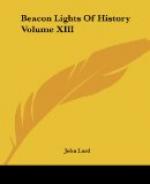At the age of fourteen the boy was sent to the University of Edinburgh, with but little money in his pocket, and forced to practise the most rigid economy. He did not make a distinguished mark at college, nor did he cultivate many friendships. He was reserved, shy, awkward, and proud. After leaving college he became a school-teacher, with no aptness and much disdain for his calling. It was then that he formed the acquaintance of Edward Irving, which ripened into the warmest friendship of his life. He was much indebted to this celebrated preacher for the intellectual impulse received from him. Irving was at the head of a school at Kirkcaldy, and Carlyle became his assistant. Both these young men were ambitious, and aspired to pre-eminence. Like Napoleon at the military school of Brienne, they would not have been contented with anything less, because they were conscious of their gifts; and both attained their end. Irving became the greatest preacher of his day, and Carlyle the greatest writer; but Carlyle had the most self-sustained greatness. Irving was led by the demon of popularity into extravagances of utterance which destroyed his influence. Carlyle, on the other hand, never courted popularity; but becoming bitter and cynical in the rugged road he climbed to fame, he too lost many of his admirers.
In ceasing to be a country schoolmaster, Carlyle did not abandon teaching. He removed to Edinburgh for the study of divinity, and supported himself by giving lessons. He had been destined by his parents to be a minister of the Kirk of Scotland; but at the age of twenty-three he entered upon a severe self-examination to decide whether he honestly believed and could preach its doctrines. Weeks of intense struggle freed him from the intellectual bonds of the kirk, but fastened upon him the chronic disorder of his stomach which embittered his life, and in later years distorted his vision of the world about him. At the recommendation of his friend Irving, then preacher at Hatton Gardens, Carlyle now became private tutor to the son of Mr. Charles Buller, an Anglo-Indian merchant, on a salary of L200; and the tutor had the satisfaction of seeing his pupil’s political advancement as a member of the House of Commons and one of the most promising men in England.
About this time Carlyle, who had been industriously studying German and French, published a translation of Legendre’s “Elements of Geometry;” and in 1824 brought out a “Life of Schiller,” a work that he never thought much of, but which was a very respectable performance. In fact, he never thought much of any of his works: they were always behind his ideal. He wrote slowly, and took great pains to be accurate; and in this respect he reminds us of George Eliot. Carlyle had no faith in rapid writing of any sort, any more than Daniel Webster had in extempore speaking. After he had become a master of composition, it took him thirteen years of steady work to write “Frederick the Great,”—about the same length of time it took Macaulay to write the history of fifteen years of England’s life, whereas Gibbon wrote the whole of his voluminous and exhaustive “History of the Decline and Fall of the Roman Empire” in twenty years.




